* This one got lost in translation for a moment so it's going to seem a little out of order. Chronologically it should come before Costa Rica. Sorry for the confusion!
About two and a half hours in a shuttle van, up some narrow windy roads, along a fairly modern highway, through a couple of traffic clogged towns, and down an even narrower windier road in a well used shuttle van and we arrived in Panajachel on the shore of Lake Atitlan. Panajachel (often shortened to Pana by the locals) is itself a carnival of noise and colors worth exploring, but we didn’t have time for that. But here is a little video that gives you a brief glimpse from the van window.
We unloaded our bags in a confusion of hombres asking us where we were going and hustling us down to the boats, la lanchas, waiting at the dock. In our ignorance, we paid 50Q
(quetzales) for what we found out later should have been a 20Q trip - oh well, live and learn, 7Q is about $1 US.
The lanchas zip around the lake all day ferrying people to and from the various communities around the shore, most of which are only accessible by boat. We stayed at La Iguana Perdida, a hostel right next to the dock at Santa Cruz. The actual village is up a long and very steep hill, so in addition to the boats, there was a constant parade of tuk tuks, little three wheeled covered scooter taxis, grinding their gears to take people up and down the hill.

Our stay at La Iguana Perdida was delightful. We had a private room (though most guests were single travelers staying in dorm rooms), and a balcony overlooking the lake.
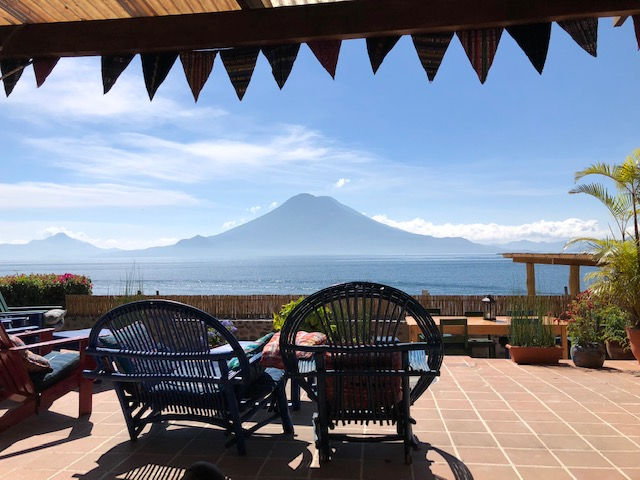
The family style dinners gave us the chance to talk to other travelers from all over the world and they didn’t seem to mind that, for most of them, we were more than twice their age, For the young folks, there are plenty of active things to do such as scuba diving, kayaking, hiking up volcanoes, or paddle boarding.
**************************************
Due to some snafus with later parts of our trip, I got behind on writing for the blog. However, David is keeping a daily journal. Following are excerpts from him about the remainder of our time at Lake Atitlan.
Day 1 - Lake Atitlan (David’s Journal)
After a hard night, being kept awake for a couple of hours by rowdy bar patrons below us, we had a terrific breakfast. We decided to arrange for getting laundry done, so, after some challenging Spanish conversation on Susan’s part with the local laundry woman, we managed to hand off our dirty laundry. Then we decided to explore Santa Cruz some — the village where we’re staying.
A big part of our interest in going up the mountainside to Santa Cruz was sparked by reading literature at the hostel about a long history of community development led by an organization founded in 1995 called CECAP. They started out working on educational opportunities for kids, then branched out into a culinary program/restaurant, plus various other vocational training — welding, etc. The story was impressive in the brochure and we wanted to see their restaurant. Here’s a view of the CECAP building from the entrance to our hotel room by the lake at Iguana. The open porch at the top is part of their restaurant, where we ate.

The village itself is a ways up the mountain, so we decided to hire a tuk tuk taxi — really a motor bike with a small passenger cabin in back for 2-3 people. It’s a good thing we did that, rather than try to walk. The road was really steep with multiple switch backs and little space on the side for pedestrians. After a rather hair-raising ride up the mountainside, we reached CECAP. We visited the beautiful gift shop and paused for a bit of food/drink at the restaurant area overlooked the lake in spectacular fashion.
There was beautiful wrought iron work on the railings — we speculated that it might have been done as part of CECAP’s training programs in metal work.
On our return, I was better prepared and took a few photos of the descent.
At the evening dinner we sat with an interesting group of young people from various parts of the world. There was young woman from Texas, currently living in Antigua to do dissertation research in anthropology, along with her friend from Tennessee. There was a French woman from Paris and her friend from Australia. Finally, there was a young man from Guatemala City, who was working toward a university degree in biology. He was touring all over Guatemala, most recently investigating bat caves. Apparently there are over 100 species of bats in Guatemala.
December 2 - Lake Atitlan (David’s Journal)
Today we grabbed a motor boat shuttle to go down the lake from Santa Cruz to another small community on the lake, San Juan.
There we got a tuk tuk to take us on a tour of a women’s textile cooperative and a place where they make chocolate.
The textile place was amazing. We were treated to a demonstration by a young woman, with interpretation by a man there into English, of the entire process for making Guatemalan textiles. She started by showing us the cotton puffs picked from nearby trees (one of which we walked under in the entryway to the workshop.) She demonstrated pulling the seeds out of the raw cotton, then pinching off a fairly small bunch of it and beating that briefly with a small wooden stick/hammer. Next she pulled out a kind of spindle that had a thick layer of thin cotton string wrapped around it, and a tapered end. She stretched out a piece of the raw cotton and twisted that into the spindle thread, then with the bunch of raw cotton in her left hand, connected to the spindle string, she began twirling the spindle while gently pulling new cotton from the bunch in her left hand. She made it look so easy! Then she asked if we wanted to try, so I jumped up and gave it a whirl. I gradually was able to make about a foot of string, then Susan tried. She was much better at it.
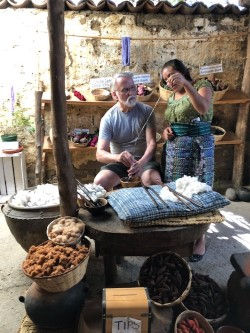

In the background, you can see the hanging samples of died string, accompanied by samples of the dye sources. After we’d each made a foot or so, she broke off the string and tied a piece around each of our wrists.
Next, she showed us the dying process. On the wall were examples of the various things they use as dye — rosemary, basil, charcoal, etc., each of which provides a particular color. She then demonstrated soaking the white cotton string in the dye to produce the colored string.
Then she took us to a weaving room where she demonstrated how they set up a weaving by winding string of various colors in and out among vertical posts.
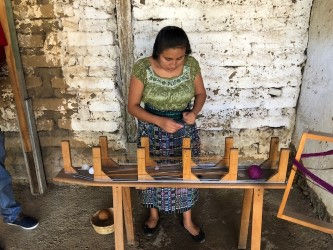
After that, she moved over to a back strap loom, laced around her waist on one end and suspended from the wall on the other. There she demonstrated passing a kind of shuttle between layers of string threaded onto the loom to create a tapestry. A couple of days later, on our return shuttle trip to Antigua, we noticed several women using such looms along the highway, as they also offered various craft products for sale to passing drivers.
Finally, they invited us to look over their store with an enormous variety of products made from the weaving. It was stunningly beautiful. Susan bought a scarf and some earrings, but we wished we had room to carry more.
Our tuk tuk driver had been waiting for us and then took us to the chocolate place. There a young woman spoke to us in English and briefly explained how they make chocolate from cacao seeds (about the size of dates) and various mixtures of honey/molasses, orange, milk, and spices and she demonstrated grinding the cacao into powder. We bought some samples of their wares.
Next our tuk tuk took us to El Artisano, an Italian-inspired restaurant with a lovely grassy courtyard and beautiful view of the mountainside behind.
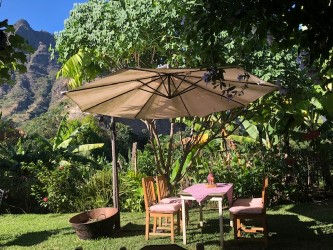
Ian had told us of this place and we were looking forward to sampling the cheese and meat (sausage/cold cuts) platters that are their specialty. We ended up getting a pheasant pate, a sample of olives, and the cheese plate. The latter featured over 20 different types of cheese, arranged in succession from mild to strong.

It was all exceptional, but very filling. We just managed to eat everything in time to catch our tuk tuk back to the dock and then the ferry boat back to Santa Cruz.
The initial part of the boat ride was pretty scary — the boat totally full of people, and riding rather low in the water. The water was choppy with late afternoon wind, and the boat captain took off at full speed. Our full stomachs were slammed repeatedly, along with our spines and the rest of our bodies as we crested waves then crashed repeatedly. Finally, we reached home at Iguana Perdida in Santa Cruz and calmed our stomachs down with their amazing Mescal.
Day 3 - Lake Atitlan (by Susan)
Lazy morning watching the boats on the lake.
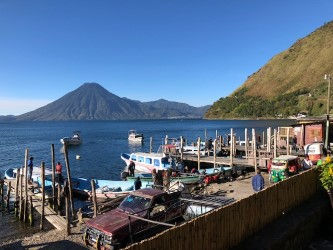
In the afternoon, the CECAP organization was having a 20th Year Celebration up in the town square, so we took a tuk tuk back up the hill to watch the festivities. We watched young boys in a drum corps banging away with enthusiasm on their drums. This was followed by various games and competitions under tent canopies but we didn’t understand any of it, so we didn’t stay long.
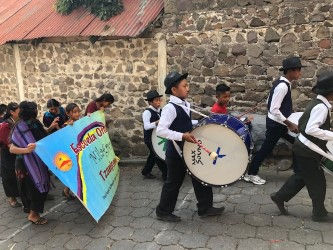
Comentarios